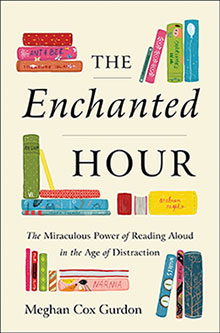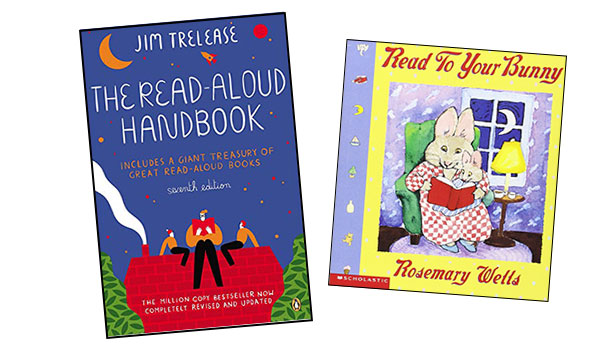When you walk into our house, you know immediately my husband and I are readers. The dining room is designated as the library, but there are bookcases and books in every single room, including the bathrooms. We subscribe to The Wall Street Journal and the Sunday New York Times, as well as Smithsonian, Audubon, and Sky and Telescope.
 My husband has been teaching himself quantum physics the last few years. I take books to the movies. Yet we both would have failed the “Goldilocks effect” if that test had been given to us as young children. In her book, The Enchanted Hour: The Miraculous Power of Reading Aloud in the Age of Distraction, Meghan Cox Gurdon discusses Dr. John Hutton’s research on how reading aloud to children affects their cognitive development.
My husband has been teaching himself quantum physics the last few years. I take books to the movies. Yet we both would have failed the “Goldilocks effect” if that test had been given to us as young children. In her book, The Enchanted Hour: The Miraculous Power of Reading Aloud in the Age of Distraction, Meghan Cox Gurdon discusses Dr. John Hutton’s research on how reading aloud to children affects their cognitive development.
Hutton, a pediatrician and professor at the Cincinnati Children’s Hospital, discovered through MRI scans that the brains of preschoolers who had been read to on a regular basis “lit up” in areas associated with language and processing information. Compared to peers who had little or no access to books, or who were given screens instead of sharing a picture book with a caregiver, the story-rich children were miles ahead in “language, emotional control, vision, hearing … laying the pathways for future thought and reasoning.”
The “Goldilocks effect” pertains to children age three to five, when their brains are growing fast. MRI scans showed “too hot” brain activity in children viewing videos. Not as terrific as it sounds, the watchers were actually passive. Audio — listening to stories through headphones — produced tepid reactions, “too cold.” The “just right” combination was being read to from a picture book. Children must process the pictures while listening. Their brains are engaged and active. And they have the added benefit of physical connection to a person.
When I read this study, I remembered my own years between two and five. There were no children’s books in the house I lived in. No one read to me. I was seldom spoken to and heard no stories. Howdy Doody and The Mickey Mouse Club (screen) kept me company. At the age of six, I entered first grade. The “look-say” or “whole word” method was still going strong. Reading didn’t click with me until second grade.

My husband was born in the Depression when children’s books were far down on the list of necessities. Next came the war, and his parents were busy with war work. He wasn’t read to and doesn’t remember any books until he started first grade. His stories came over radio waves (audio), Inner Sanctum and One Step Beyond.
I can’t say either of us grew up in a time of few distractions. For my husband, the war ruled everyone’s lives. By the time it was over, he was twelve, well past those vital development years. My life stabilized when I turned five, but my parents had multiple jobs. Learning to read and being exposed to books was left to teachers.
The Enchanted Hour covers other studies that prove the importance of reading aloud to young children, such as vocabulary. Reading two picture books aloud to a child each day for a year exposes him or her to more than 438,000 words of text. Catherine Tamis-LeMonda of New York University believes that picture book time is the only setting in which parent and child talk about things other than daily routines. Where else can you discuss the moon or elephants or how birthdays are celebrated in other countries?
The book includes test results of children in lower socioeconomic situations: book- and word-poor households. My background. And yet I did learn to read, though rather late. Once the door to stories was open, I read and wrote them. Library books had to be returned, but the stories I wrote were mine. No one could take them away from me.
My husband did fine in language arts, but his interests lay in mathematics and science. My mother wanted me to get a desk job. My husband’s father urged him to join his building business. Without encouragement, we found our own motivation and followed our own paths.
Gurdon’s book made me wistful. What would my life had been like if someone read me bedtime stories? If I was taken to the library? If someone stopped to listen to one of my own stories? But I can’t go back to my preschool years and fill that gap. The arrow of time — a theory developed by physicist Arthur Eddington in 1927 — only moves in one direction, forward. The past is fixed and immutable.

I worry about children like me, growing up in word- and book-poor homes. The plea of The Enchanted Hour is for parents to carve out an hour a day to read aloud to their children. This isn’t a new idea. Jim Trelease’s 1979 The Read-Aloud Handbook paved that road for parents forty years ago. In 1998, Read to Your Bunny by Rosemary Wells was published as part of her initiative urging families to set aside twenty minutes a day of read-aloud time. Down from an hour to twenty minutes, and yet the problem still exists.
Here we are at the same crossroads, but now the enemy is screen time. No one reading this column is unaware that screens are in the hands of younger and younger children. I see babies with cellphones “to keep them quiet” and I see the expressionless faces of their parents, also on screens. Children in families that are poor in books but rich in screens — no matter where they land on the socioeconomic scale — will struggle to develop lively imaginations, to escape the pull of social media, to follow their own paths, with or without encouragement.
The arrow of time only moves in one direction, forward. Once passed by, those important years can’t be reclaimed and fixed.
